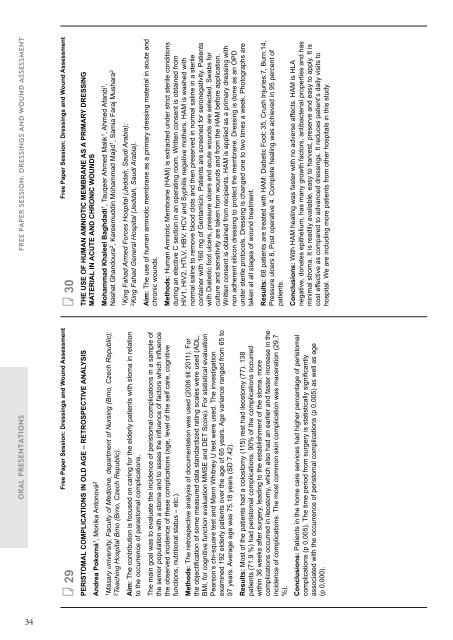You also want an ePaper? Increase the reach of your titles
YUMPU automatically turns print PDFs into web optimized ePapers that Google loves.
ORAL PRESENTATIONS<br />
29<br />
Free Paper Session: Dressings and Wound Assessment<br />
PERISTOMAL COMPLICATIONS IN OLD AGE – RETROSPECTIVE ANALYSIS<br />
Andrea Pokorná 1 , Monika Antonová 2<br />
1 Masary university, Faculty of Medicine, department of Nursing (Brno, Czech Republic);<br />
2 Teaching Hospital Brno (Brno, Czech Republic).<br />
Aim: The contribution is focused on caring for the elderly patients with stoma in relation<br />
to the occurrence of parastomal complications.<br />
The main goal was to evaluate the incidence of peristomal complications in a sample of<br />
the senior population with a stoma and to asses the influence of factors which influence<br />
the observed incidence of these complications (age, level of the self care, cognitive<br />
functions, nutritional status – etc.).<br />
Methods: The retrospective analysis of documentation was used (2006 till 2011). For<br />
the objectification of some measured data standardized rating scales were used (ADL,<br />
BMI, for cognitive function evaluation MMSE and DET Score). For statistical evaluation<br />
Pearson’s chi-square test and Mann Whitney U test were used. The investigation<br />
examined 192 elderly patients over the age of 65 years. Age variance ranged from 65 to<br />
97 years. Average age was 75.18 years (SD 7.42).<br />
Results: Most of the patients had a colostomy (115) rest had ileostomy (77). 138<br />
patients (71.9 %) had peristomal complications. 90% of the complications occurred<br />
within 36 weeks after surgery, leading to the establishment of the stoma, more<br />
complications occurred in ileostomy, which also had an earlier and faster increase in the<br />
incidence of complications. The most common skin complication was maceration (29.7<br />
%).<br />
Conclusions: Patients in the home care services had higher percentage of peristomal<br />
complications (p 0,005). The time period from surgery is statistically significantly<br />
associated with the occurrence of peristomal complications (p 0,005) as well as age<br />
(p 0,000).<br />
FREE PAPER SESSION: DRESSINGS AND WOUND ASSESSMENT<br />
30<br />
Free Paper Session: Dressings and Wound Assessment<br />
THE USE OF HUMAN AMNIOTIC MEMBRANE AS A PRIMARY DRESSING<br />
MATERIAL IN ACUTE AND CHRONIC WOUNDS<br />
Mohammad Khaleel Baghdadi 1 , Tauqeer Ahmed Malik 1 , Ahmed Afandi 1 ,<br />
Nashat Ghandoura 2 , Kareemuddin Mohammad Majid 1 , Samia Faraj Mushara 2<br />
1 King Fahad Armed Forces Hospital (Jeddah, Saudi Arabia);<br />
2 King Fahad General Hospital (Jeddah, Saudi Arabia).<br />
Aim: The use of human amniotic membrane as a primary dressing material in acute and<br />
chronic wounds.<br />
Methods: Human Amniotic Membrane (HAM) is extracted under strict sterile conditions<br />
during an elective C section in an operating room. Written consent is obtained from<br />
HIV1, HIV2, HTLV, HBV, HCV and Syphilis negative mothers. HAM is washed with<br />
normal saline to remove blood clots and then preserved in normal saline in a sterile<br />
container with 160 mg of Gentamicin. Patients are screened for seronegativity. Patients<br />
with Diabetic foot ulcers, pressure ulcers and acute wounds are selected. Swabs for<br />
culture and sensitivity are taken from wounds and from the HAM before application.<br />
Written consent is obtained from recipients. HAM is applied as a primary dressing with<br />
non adherent silicon dressing to protect the membrane. Dressing is done as an OPD<br />
under sterile protocols. Dressing is changed one to two times a week. Photographs are<br />
taken at all stages of wound treatment.<br />
Results: 68 patients are treated with HAM: Diabetic Foot: 35, Crush Injuries:7, Burn:14,<br />
Pressure ulcers 8, Post operative 4. Complete healing was achieved in 95 percent of<br />
patients.<br />
Conclusions: With HAM healing was faster with no adverse affects. HAM is HLA<br />
negative, donates epithelium, has many growth factors, antibacterial properties and has<br />
minimal stroma. It is readily available, easy to harvest, preserve and easy to apply. It is<br />
cost effective as compared to advanced dressings. It reduces patient’s daily visits to<br />
hospital. We are including more patients from other hospitals in this study.<br />
34






